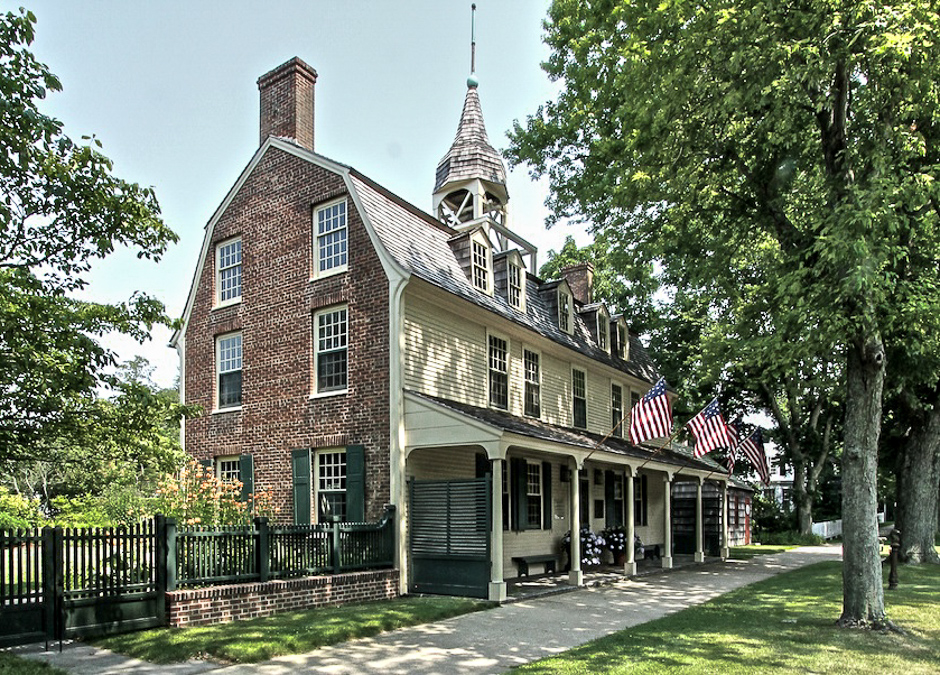
TREASURES of the
EAST HAMPTON HISTORICAL SOCIETY

~~~~~~~~~~~~~~~~~~~~~~~~~~~~~~~~~
‘
Exhibit Closed, 2022
~ ~ ~ ~ ~ ~ ~ ~ ~ ~ ~ ~ ~ ~ ~ ~ ~ ~ ~ ~ ~ ~
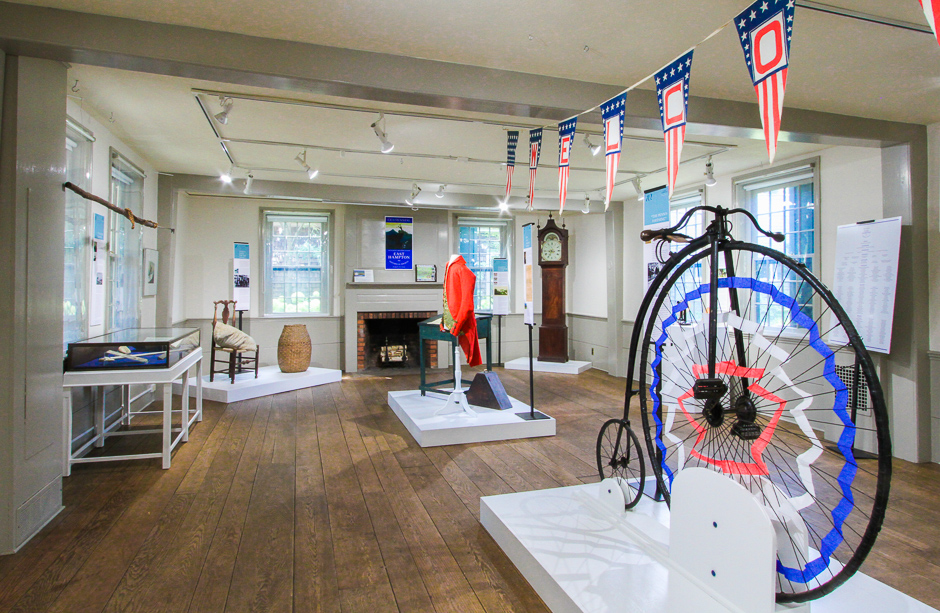
High wheel bicycles, also commonly known as “penny-farthings”.
The Penny-Farthing was the first vehicle to be called a “bicycle.” Popular in the 1870’s, it was named after British coins: a penny being the largest coin (the front wheel) and a farthing being the smallest (the rear wheel.) Known for its speed, it was also dangerous as a rider could easily hit a bump and pitch forward from a high height. By the 1890’s they were replaced by “safety bicycles” as we know them with smaller wheels and chain-driven gears.
From the Collection of the East Hampton Historical Society Gift of Donald M. Halsey.
__________________________________________
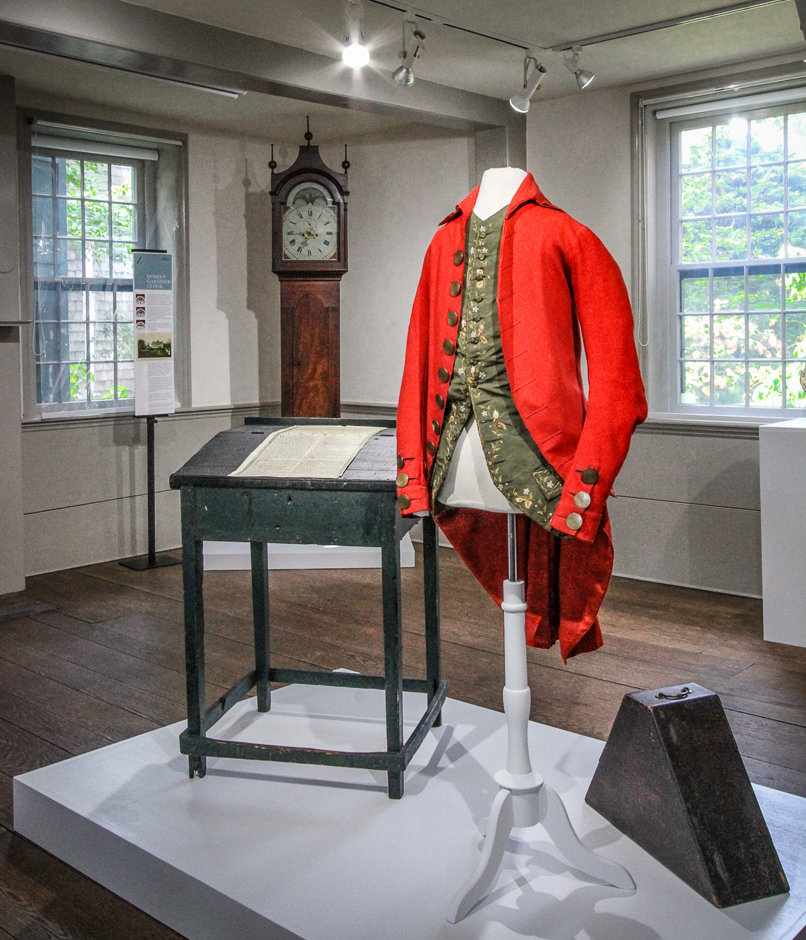
Mulford Broadcloth Coat, circa 1720-1780
This gentlemen’s 18th century red wool broadcloth coat with large brass buttons descended through East Hampton’s Mulford family. Long-time East Hampton Historical Society curator Richard Barons identified the most likely wearer of the coat, based on the date of the wool used, to be Samuel “Fishhook” Mulford (1644-1725).
From the Collection of the East Hampton Historical Society Gift of James Hedges Mulford.
————–
Tricorn Hat Box, circa 1790 – 1800
This trapezoidal pine case with mahogany stain exterior and brass hinges would have been used by a gentleman to store his tricorn hat during the 18th century. As men’s wigs became fashionable during the colonial era, tricorn or “cocked” three-cornered hats also grew popular.
From the Collection of the East Hampton Historical Society.
~ ~ ~ ~ ~ ~ ~ ~ ~ ~ ~ ~ ~ ~ ~ ~ ~ ~ ~ ~ ~ ~


of the Declaration of Independence remained in the family and sold at auction in 2017 for $1.8 million.
The Declaration of Independence printed by John Holt, July 11, 1776.
__________________________________________
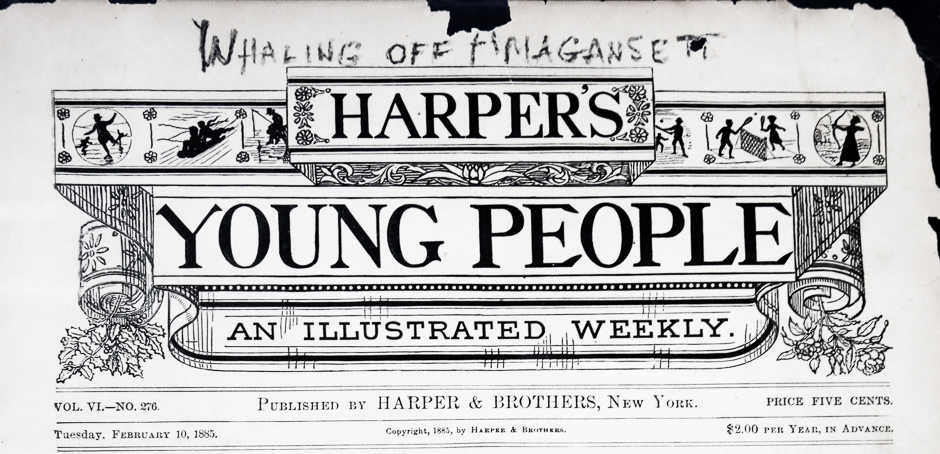
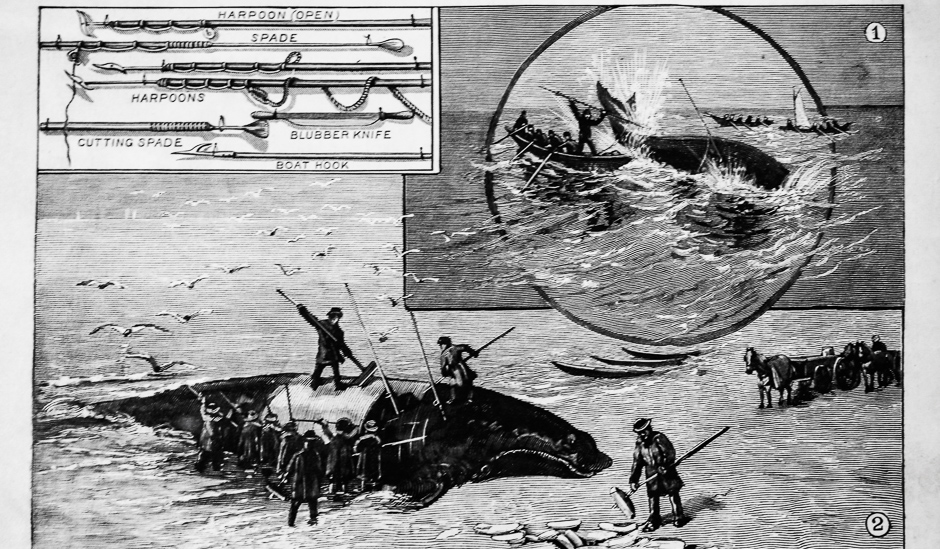
‘Whale-Fishing Off Long Island’
Harper’s Young People was an illustrated weekly magazine published for school-aged boys and girls between 1879 and 1899 by Harper & Brothers (Harper’s Bazaar). This cover of the February 10, 1885, edition shows scenes depicting “Whale-Fishing off Long Island.”
Whaling was an important local industry from the mid-18th century. The whale blubber was brought to shore where it was boiled down to oil for lamps. The first tryworks was on Highway Behind the Pond.
Later whalers had to go further afield in search of whales and sailors could be away from home for years, carving scrimshaw to pass the time. Captain Sylvester Miller’s 1835 logbook of the ship Bayard shows a whale symbol in the margin for each catch. The peak was reached in the 1840’s when the returns became too small for the enormous risks and many sailors joined the 1849 California Gold Rush.
Beached whales washed ashore locally were eagerly spotted by schoolboys from the belfry of Clinton Academy and school would be canceled as the town turned out to harvest the valuable carcass.
From the Collection of the East Hampton Historical Society.
~ ~ ~ ~ ~ ~ ~ ~ ~ ~ ~ ~ ~ ~ ~ ~ ~ ~ ~ ~ ~ ~
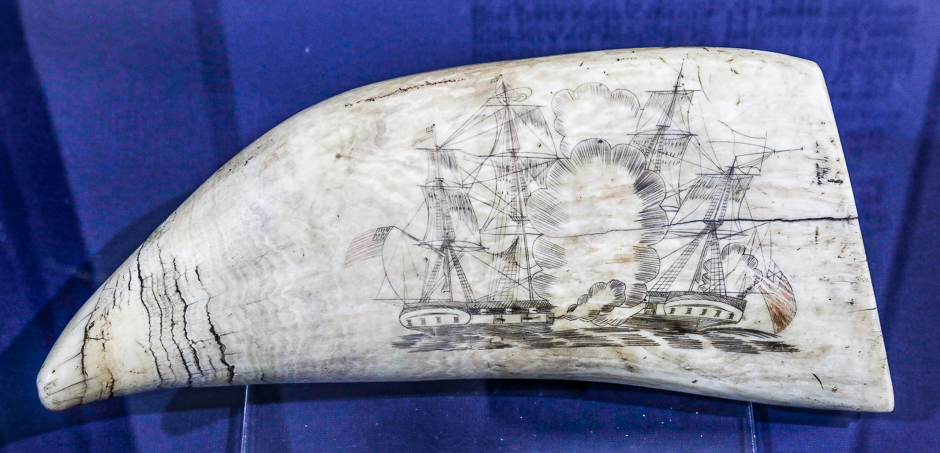
Scrimshaw Whale Tooth, circa 1812
USS Constitution and the British frigate HMS Guerriere on August 19, 1812, near Nova Scotia
during the War of 1812.
From the Collection of the East Hampton Historical Society.
~ ~ ~ ~ ~ ~ ~ ~ ~ ~ ~ ~ ~ ~ ~ ~ ~ ~ ~ ~ ~ ~

Claus Hoie (1911-2007)
Harpooner, 1994
Claus Hoie was born to a seafaring family in Stavanger, Norway in 1911 and immigrated to the U.S. when he was 13 years old. After growing up in Brooklyn, he studied art at the Pratt Institute in New York, the Art Students League, and the Ecole des Beaux Arts in Paris. Hoie also spent two years at sea with the Merchant Marine and assisted with the liberation of Norway as a sergeant in the U.S. Army during World War II.
In the 1960s, Hoie and his wife (artist Helen Hoie) moved to East Hampton and resided here until his death in 2007 at the age of 95. While his work was often diverse in subject, Hoie often focused on scenes related to maritime life due to his love of the sea and its creatures. Additional paintings created by this extraordinary local artist can be viewed in the Claus Hoie Gallery of Whaling on the rst oor of the East Hampton Town Marine Museum on Blu Road in Amagansett.
__________________________________________
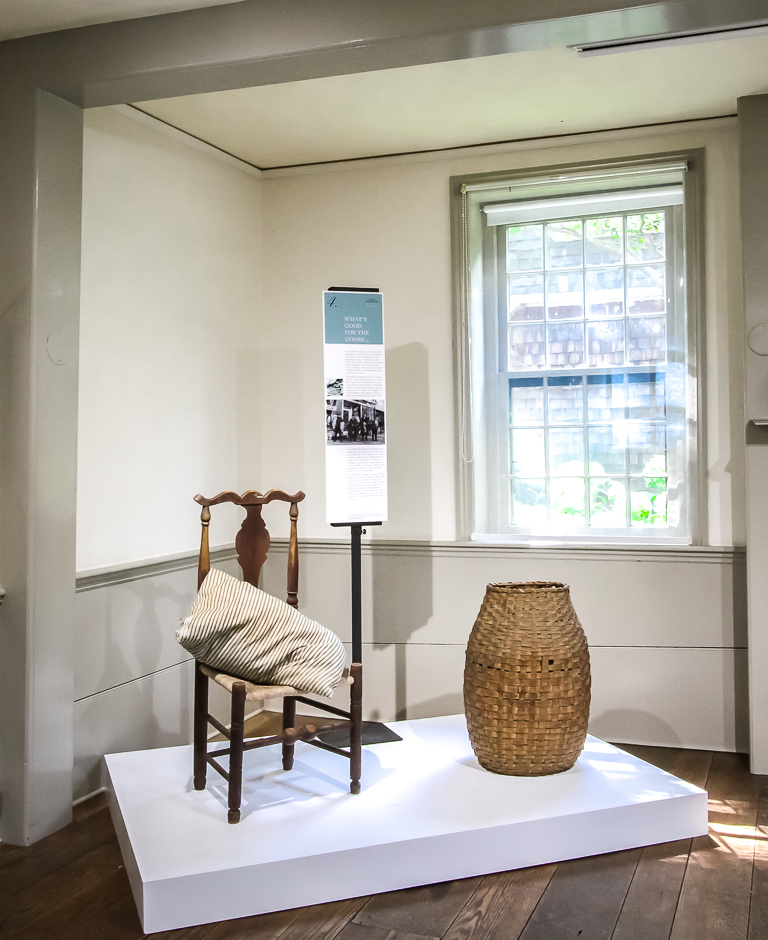
Fiddle-Back Side Chair, circa 1790-1810
This fiddle-back side chair, with original finish and replaced rush seat, was likely created by famed local craftsman Nathaniel Dominy V and is part of the William Efner Wheelock Collection. A former summer resident and incorporating member of the East Hampton Historical Society, Dr. Wheelock was an avid collector of artifacts documenting the region’s early American history.
From the Collection of the East Hampton Historical Society Gift of William Efner Wheelock and John Hall Wheelock.
————
Feather Basket, circa 19th century
Wood splint
This feather basket was crafted by members of the local Montaukett tribe using traditional indigenous wood splint weaving techniques. It was intentionally shaped to fit a large goose within and contain the down as the goose was plucked.
From the Collection of the East Hampton Historical Society.
__________________________________________

DOMINY GARDINER CLOCK
Eight-Day, Strike, Repeater, and Alarm Tall-Case Clock, 1791.
From the Collection of the East Hampton Historical Society.
————
In 1791 this elaborate 8 foot tall clock was custom ordered for John Lyon Gardiner (1770-1816), the 7th proprietor of Gardiner’s Island. Working from their shop on North Main Street, famed local East Hampton craftsmen Nathaniel Dominy IV and his son Nathaniel Dominy V, using imported mahogany and an English dial, showing the phases of the moon, signed and dated the clock:
“N. Dominie fecit 1791, Novr for John Lyon Gardiner $70”
————
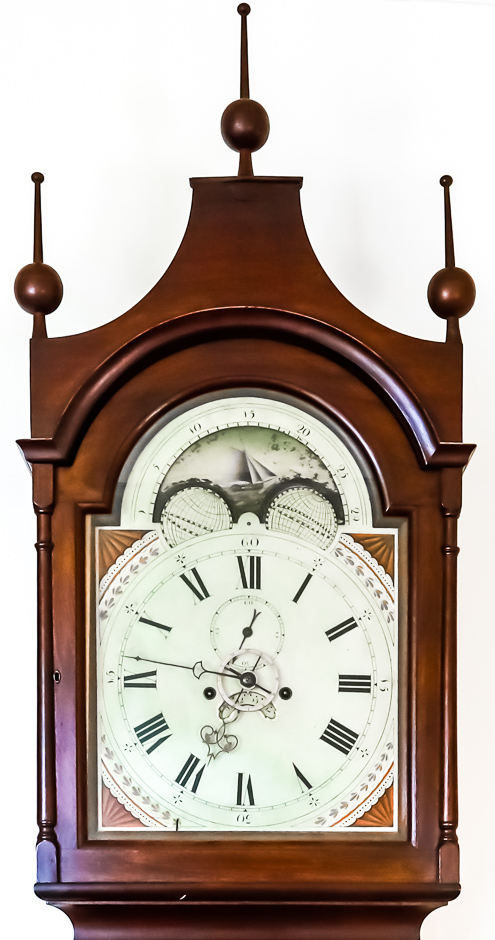
From the Collection of the East Hampton Historical Society
__________________________________________
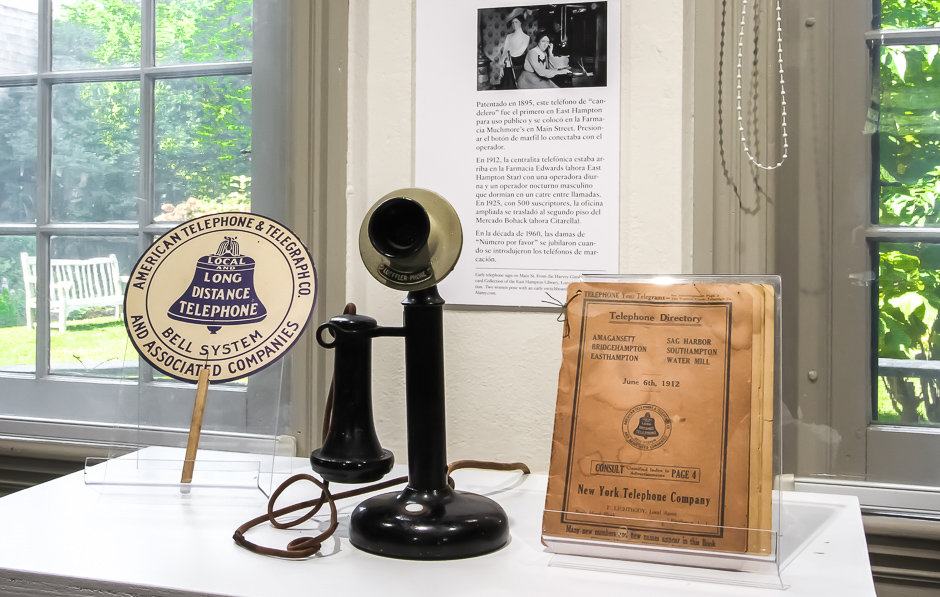
“NUMBER PLEASE”
Loeffler-Phone, circa 1910-1930
This candlestick (or pole) telephone was created by the Loeffler-Phone Manufacturing Company
of New York in the first decades of the 20th century. Use of candlestick phones like this one
began in the 1890s and continued for the next few decades.
From the Collection of the East Hampton Historical Society Gift of Mrs. Malcolm P Aldrich.
__________________________________________

Coast Guard Station, Amagansett
NAZI SPIES
At 12:30 a.m. on June 13, 1942, a German submarine surfaced in dense fog 500 yards off the Amagansett beach and four Nazi spies came ashore in a rubber raft. They were surprised by Seaman John Cullen who was patrolling the beach on foot.
Pretending to accept a bribe as ‘hush money’, he returned to the Coast Guard Station to give the alarm. Returning with three armed colleagues, the Coast Guardsmen uncovered four crates buried in the sand containing Nazi uniforms, dynamite and timing devices.
but the FBI had already been alerted to follow them.

Coast Guardsman John C. Cullen
__________________________________________
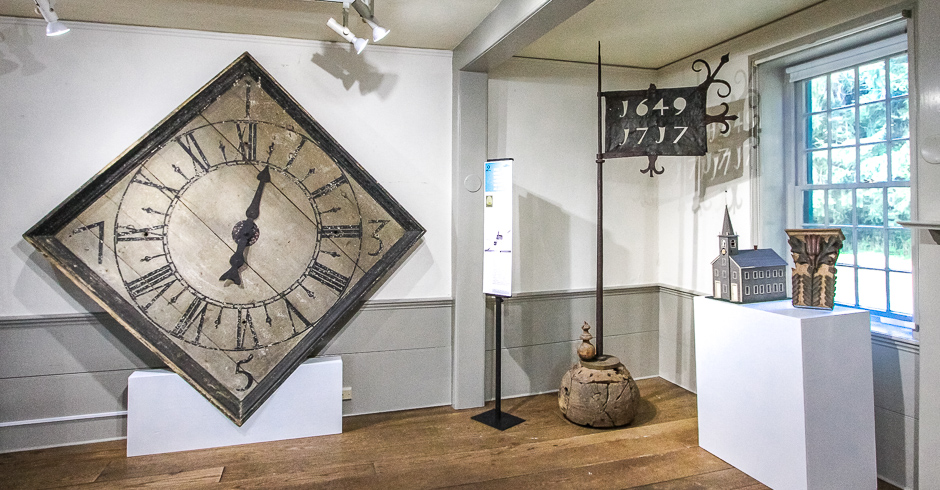
Tower Clock Face from the “1717” Church
This clock face was installed on East Hampton’s Presbyterian Church in either 1735 or 1753—when a tower and steeple were added to the original structure built in 1717. In an era when clocks were affordable only to the wealthy, this large timepiece set the pace for life in the entire village for over a century. Mounted on the front of the church facing Main Street, the diagonal dial had only one hand that indicated the hour.
From the Collection of the East Hampton Historical Society Gift of George Schellinger.
————

Banner Weathervane
1649 marks the date of European settlement and construction of the first thatch-roofed meeting house in East Hampton, while 1717 was the year a new church was built to replace the first. When a tower, clock, and steeple were added to the building (in either 1735 or 1753), this vane was constructed and installed at the top of the structure to honor the church’s long lineage. The ball at the base was covered in copper and gold leaf. In 1861 the original church was torn down and relocated further east on Main Street.
From the Collection of the East Hampton Historical Society.
————
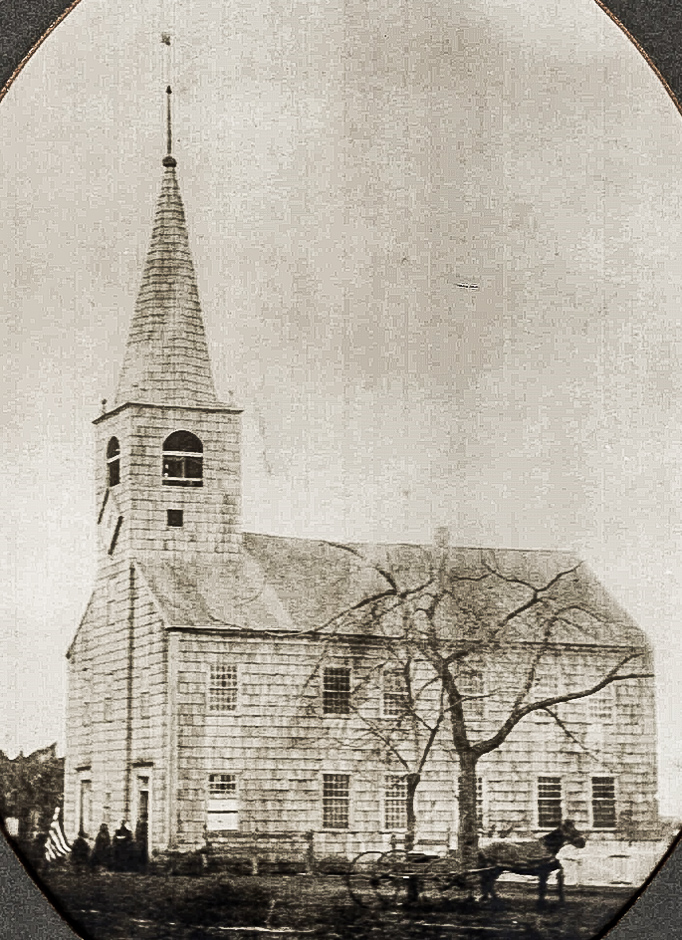
Photograph of the Church, undated. From the Collection of the East Hampton Historical Society.

Survey of Main Street East Hampton, 1833. Courtesy of the East Hampton Library, Long Island Collection.
————
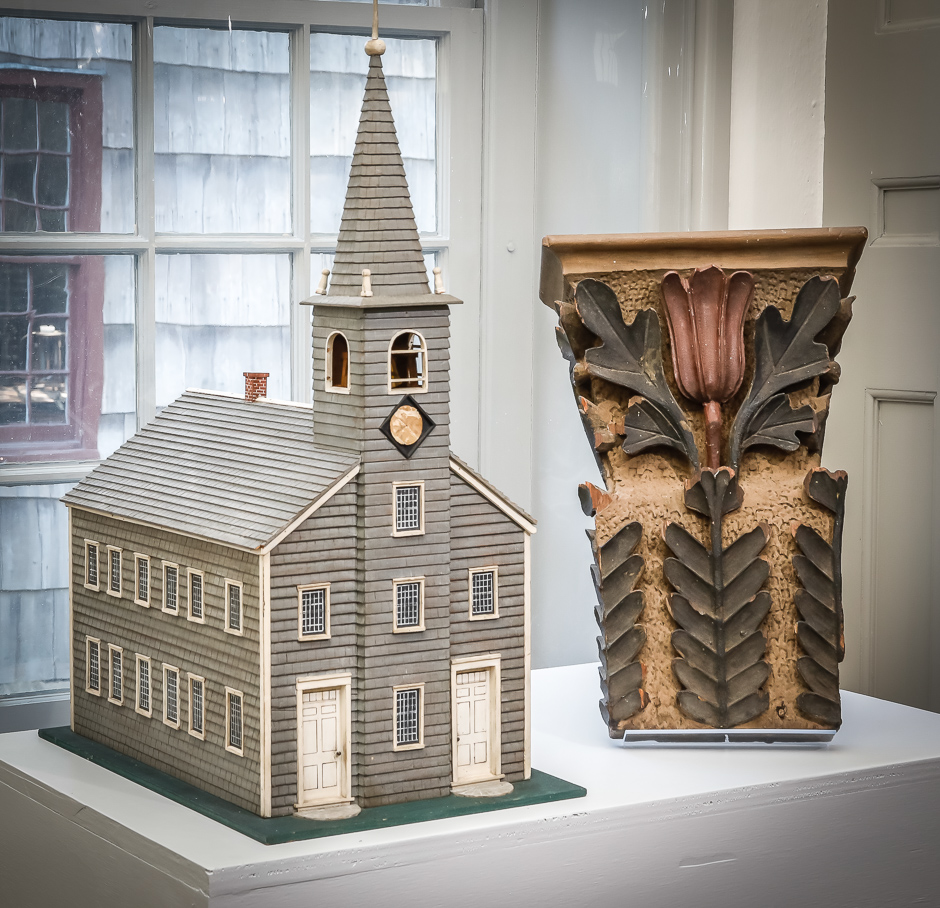
“1717” Church Miniature, circa 1940
This wooden, handcrafted model presents a 3-D view of what East Hampton’s “1717” Church looked like from 1823 until the present Presbyterian Church was built a bit further north on Main Street in 1861. The tower, diagonal dial clock, and steeple additions of the mid-18th century are clearly visible. The two doors portrayed on each side of the front tower are a result of a relocation made around 1822-1823 of the church’s main entry way from its side in order to face Main Street.
From the Collection of the East Hampton Historical Society Gift of Asa O. Jones.
————
Cornice from the “1717” Church, 1758
Created by Alexander Grant of South Windsor, Connecticut, this architectural element was part of a decorative arch located within the “1717” Church behind the minister’s pulpit— from which both Rev. Samuel Buell and Rev. Lyman Beecher delivered sermons during their tenures as minister.
From the Collection of the East Hampton Historical Society Gift of Hugh C. Filer.
~ ~ ~ ~ ~ ~ ~ ~ ~ ~ ~ ~ ~ ~ ~ ~ ~ ~ ~ ~ ~ ~
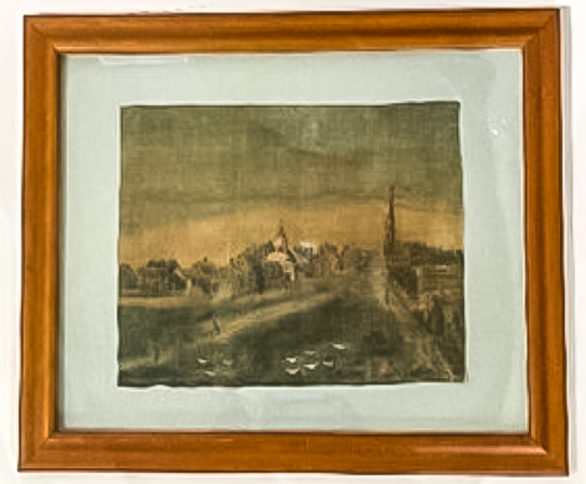
View of 18th Century East Hampton, undated
Paint on velvet, artist unknown
In this velvet painting depicting 18th century daily life in the village of East Hampton, the “1717” church can be seen on the right— complete with clock tower and weathervane. The equally imposing structure of Clinton Academy, with belfry, is visible on the opposite side of Main Street.
From the Collection of the East Hampton Historical Society Gift of Mary Fisher Torrance
__________________________________________

PORTRAIT OF REVEREND SAMUEL BUELL (1716 – 1798)
Oil on canvas, artist unknown, likely Connecticut River Valley, circa 1785.
The Reverend Samuel Buell was born in Coventry, Connecticut in 1716, educated at Yale University, and became pastor in East Hampton in 1746. An early local intellectual leader and the only clergyman within 40 miles of East Hampton during the American Revolution, Rev. Buell served as minister of the village’s Presbyterian Church for 50 years.
Together with several other wealthy residents, Rev. Buell created Clinton Academy in 1784—one of the first secondary schools to be opened in New York State and chartered by the Board of Regents after the war. The school was co-educational and accepted both young men and ladies, with students hailing from a broad range of locations such as Long Island, New York City, New Jersey, Connecticut, and as far away as the West Indies.
From the Collection of the East Hampton Historical Society
————
Reverend Buell’s Wig, circa 1750
Horsehair, human hair, cotton, silk
Rev. Buell was an affluent resident of East Hampton. He owned property, slaves, livestock, and a home located on the corner of Buell Lane and Main Street (where the East Hampton Library now stands) filled with fine objects reflecting the latest fashions. Buell’s wig is styled in the mode of the time that favored curly locks.
From the Collection of the East Hampton Historical Society Gift of Ettie Hedges Pennypacker.
————
Reverend Buell’s Wig Box, circa 1750
This continental, oval-shaped banded box with painted oral decoration was used by Reverend Samuel Buell to store his white wig when not in use.
From the Collection of the East Hampton Historical Society Gift of Ettie Hedges Pennypacker.
————
Reverend Buell’s Windsor Armchair, circa 1780-1790
This brace-back Windsor armchair was once owned and used by Reverend Samuel Buell (1716-1798) and is the very chair Buell is depicted as sitting in while at work in his library in the 1785 Portrait of Reverend Samuel Buell. Windsor chairs were very popular in both rural and urban areas at the turn of the 18th century and could be found in virtually every room of a home.
From the Collection of the East Hampton Historical Society Gift of Frances Gardiner Collins.
~~~~~~~~~~~~~~~~~~~~~~
Reverend Buell’s Table, circa 1780-1790
This Pembroke table was once owned and used by Reverend Samuel Buell (1716-1798) and is the exact table Buell is depicted as sitting at while at work in his library in the 1785 Portrait of Reverend Samuel Buell. It is distinguished by its small size and two drop leaves. Tables such as this were used for a variety of purposes in early America and were sometimes also known as breakfast tables.
From the Collection of the East Hampton Historical Society Gift of Rosalie Miller Swezy.
~~~~~~~~~~~~~~~~~~~~~~

Lyman Beecher, Windsor Chair, circa 1797
This writing-arm Windsor chair was made by Ebenezer Tracy, of Lisbon, Connecticut, for Lyman Beecher (1775-1863) after his graduation from Yale University in 1797. One of America’s most influential religious thinkers and reformers, Beecher grew up in Connecticut and was the son of a New Haven blacksmith. In 1798, after attending Yale Divinity School, he saw a newspaper obituary announcing the death of Rev. Samuel Buell and applied for the late minister’s post. He was hired shortly afterwards, before he was even ordained.
During the next twelve years Beecher spent as minister of the East Hampton’s Presbyterian Church, he composed many sermons upon this great chair’s writing desk. His daughter, author Harriet Beecher Stowe, was born the year after the family left the area. Yet, in her autobiography she fondly recalls memories of her father hard at work in this very Windsor chair. Beecher’s beloved chair always traveled with him and remained in his possession until his death in 1863 at age 87.
From the Collection of the East Hampton Historical Society

Harriet Beecher Stow, Lyman Beecher, and Henry Ward Beecher, circa 1860.
Courtesy of the New York Public Library.
__________________________________________

————————-
Content courtesy of the East Hampton Historical Society,
selected, edited & arranged here from the ‘Top Ten Treasures’ exhibit / 2022,
with supplemental photography © Jeff Heatley.
————-
AAQ thanks Steve Long, EHHS Executive Director, for the suggestion and for exhibit access;
as well as Jaime Karbowiak for providing supplemental information.
——————–

_________________________________________________________________
